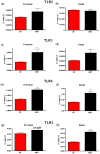Toll-like receptor mRNA expression is selectively increased in the colonic mucosa of two animal models relevant to irritable bowel syndrome
- PMID: 20011045
- PMCID: PMC2785428
- DOI: 10.1371/journal.pone.0008226
Toll-like receptor mRNA expression is selectively increased in the colonic mucosa of two animal models relevant to irritable bowel syndrome
Abstract
Background: Irritable bowel syndrome (IBS) is largely viewed as a stress-related disorder caused by aberrant brain-gut-immune communication and altered gastrointestinal (GI) homeostasis. Accumulating evidence demonstrates that stress modulates innate immune responses; however, very little is known on the immunological effects of stress on the GI tract. Toll-like receptors (TLRs) are critical pattern recognition molecules of the innate immune system. Activation of TLRs by bacterial and viral molecules leads to activation of NF-kB and an increase in inflammatory cytokine expression. It was our hypothesis that innate immune receptor expression may be changed in the gastrointestinal tract of animals with stress-induced IBS-like symptoms.
Methodology/principal findings: In this study, our objective was to evaluate the TLR expression profile in the colonic mucosa of two rat strains that display colonic visceral hypersensitivity; the stress-sensitive Wistar-Kyoto (WKY) rat and the maternally separated (MS) rat. Quantitative PCR of TLR2-10 mRNA in both the proximal and distal colonic mucosae was carried out in adulthood. Significant increases are seen in the mRNA levels of TLR3, 4 & 5 in both the distal and proximal colonic mucosa of MS rats compared with controls. No significant differences were noted for TLR 2, 7, 9 & 10 while TLR 6 could not be detected in any samples in both rat strains. The WKY strain have increased levels of mRNA expression of TLR3, 4, 5, 7, 8, 9 & 10 in both the distal and proximal colonic mucosa compared to the control Sprague-Dawley strain. No significant differences in expression were found for TLR2 while as before TLR6 could not be detected in all samples in both strains.
Conclusions: These data suggest that both early life stress (MS) and a genetic predisposition (WKY) to stress affect the expression of key sentinels of the innate immune system which may have direct relevance for the molecular pathophysiology of IBS.
Conflict of interest statement
Figures




Similar articles
-
Increased Expression of Toll-Like Receptors 4, 5, and 9 in Small Bowel Mucosa from Patients with Irritable Bowel Syndrome.Biomed Res Int. 2017;2017:9624702. doi: 10.1155/2017/9624702. Epub 2017 Jan 29. Biomed Res Int. 2017. PMID: 28246611 Free PMC article.
-
Role of toll like receptors in irritable bowel syndrome: differential mucosal immune activation according to the disease subtype.PLoS One. 2012;7(8):e42777. doi: 10.1371/journal.pone.0042777. Epub 2012 Aug 17. PLoS One. 2012. PMID: 23028414 Free PMC article.
-
Early-life stress selectively affects gastrointestinal but not behavioral responses in a genetic model of brain-gut axis dysfunction.Neurogastroenterol Motil. 2015 Jan;27(1):105-13. doi: 10.1111/nmo.12486. Epub 2014 Dec 2. Neurogastroenterol Motil. 2015. PMID: 25443141
-
Development, validation and implementation of an in vitro model for the study of metabolic and immune function in normal and inflamed human colonic epithelium.Dan Med J. 2015 Jan;62(1):B4973. Dan Med J. 2015. PMID: 25557335 Review.
-
Pathogenesis of irritable bowel syndrome--review regarding associated infection and immune activation.Digestion. 2013;87(3):204-11. doi: 10.1159/000350054. Epub 2013 May 23. Digestion. 2013. PMID: 23712295 Review.
Cited by
-
From cytokines to toll-like receptors and beyond - current knowledge and future research needs in irritable bowel syndrome.J Neurogastroenterol Motil. 2010 Oct;16(4):363-73. doi: 10.5056/jnm.2010.16.4.363. Epub 2010 Oct 30. J Neurogastroenterol Motil. 2010. PMID: 21103418 Free PMC article.
-
Irritable bowel syndrome: a microbiome-gut-brain axis disorder?World J Gastroenterol. 2014 Oct 21;20(39):14105-25. doi: 10.3748/wjg.v20.i39.14105. World J Gastroenterol. 2014. PMID: 25339800 Free PMC article. Review.
-
Increased Expression of Toll-Like Receptors 4, 5, and 9 in Small Bowel Mucosa from Patients with Irritable Bowel Syndrome.Biomed Res Int. 2017;2017:9624702. doi: 10.1155/2017/9624702. Epub 2017 Jan 29. Biomed Res Int. 2017. PMID: 28246611 Free PMC article.
-
Irritable Bowel Syndrome: Peripheral Mechanisms and Therapeutic Implications.Clujul Med. 2014;87(2):73-9. doi: 10.15386/cjmed-269. Epub 2014 May 30. Clujul Med. 2014. PMID: 26528001 Free PMC article. Review.
-
Minireview: Gut microbiota: the neglected endocrine organ.Mol Endocrinol. 2014 Aug;28(8):1221-38. doi: 10.1210/me.2014-1108. Epub 2014 Jun 3. Mol Endocrinol. 2014. PMID: 24892638 Free PMC article. Review.
References
-
- Drossman DA, Camilleri M, Mayer EA, Whitehead WE. AGA technical review on irritable bowel syndrome. Gastroenterology. 2002;123:2108–2131. - PubMed
-
- Quigley EM. Current concepts of the irritable bowel syndrome. Scand J Gastroenterol. 2003;(Suppl):1–8. - PubMed
-
- Mayer EA, Collins SM. Evolving pathophysiologic models of functional gastrointestinal disorders. Gastroenterology. 2002;122:2032–2048. - PubMed
-
- Mayer EA, Naliboff BD, Craig AD. Neuroimaging of the brain-gut axis: from basic understanding to treatment of functional GI disorders. Gastroenterology. 2006;131:1925–1942. - PubMed
Publication types
MeSH terms
Substances
LinkOut - more resources
Full Text Sources
Other Literature Sources

